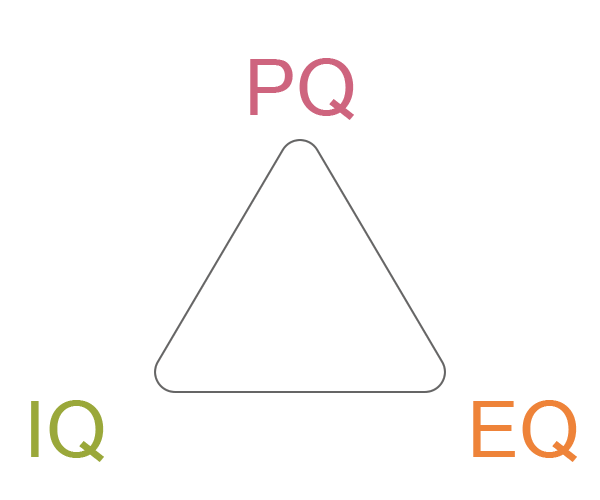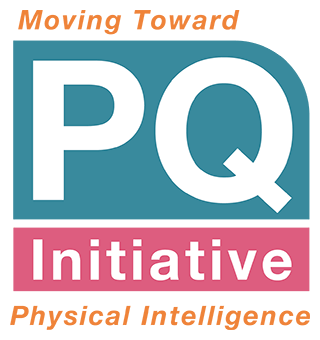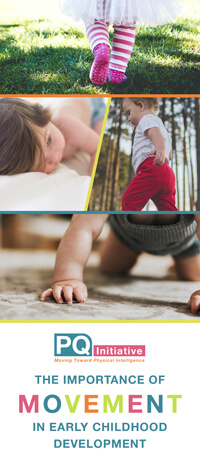
Why PQ?
We know physical activity is good for us. It makes us healthier in many ways, positively impacting every system of our body. Physical activity gives us stronger muscles, a more efficient cardiovascular system, keeps our digestive system in top working order, strengthens our immune system, sharpens our mental focus and pumps happy hormones into our blood stream. When we move our bodies in ways that challenge the status quo, our bodies respond by creating stronger muscles, more blood vessels, and new nerve cells with stronger nerve cell communication. And these are just a few of the amazing benefits of staying active. Moderate to vigorous exercise increases the number of special organelles in our cells called mitochondria that perform the essential role of managing the energy production needed for everything our brain and body does. The bottom line? We have to move to be healthy in mind, body and spirit.
We have known this for a long time and yet, people still struggle to meet the necessary recommendations for physical activity. More recent research has focused on how movement affects brain function; specifically attention, memory and problem solving, the components of Executive Function. There is ample research showing that movement improves executive function and staves off mental decline as we age. Movement is even used to slow the effects of and reduce risk for neurodegenerative disorders such as Alzheimer’s. Go to any community center or YMCA and you will find special movement classes, like Tai Chi, for older adults. Gym memberships and classes are often subsidized because insurance costs go down when people are more physically active.

The research is clear. Physical movement is a powerful catalyst for human health, and specifically for brain function. If physical activity is such a magic elixir, why do we wait until retirement age to prioritize it? Knowing what we know about how the brain and body develop, why isn’t there a greater focus during the most formative window of brain development, during the first three years of life? If we know the extraordinary benefits of movement for optimal development of executive function, why isn’t more attention paid to how movement affects brain function at the beginning of life, rather than at the end?
Here are a few reasons this may be happening:
- Money motivates: Public and private insurers have realized the cost of inactivity in older adult populations. According to the CDC, nearly 90 cents of every dollar spent on healthcare in the U.S., goes to treating a preventable chronic disease. Many healthcare models are shifting to value-based payment models, placing the financial incentive on preventing and managing disease. Unfortunately, most of these initiatives are focused on the final decades of life. The Heckman Equation makes the argument for early childhood investment but, as yet, it is not a policy priority in the U.S.
- Lack of research: Conducting physical development assessments on children is difficult. There can be ethical and logistical challenges, especially before children enter institutional settings. The consequences of physical and mental decline don’t appear until later in life. Research on Adverse Childhood Experiences (ACEs) has made inroads but there is still a lack of universal screening and treatment models. Perhaps the most promising is Dr. Bruce Perry's Neurosequential Model.
- Cultural Norms: Systems and values in the U.S. prioritize academic achievement and career success. This has led to prioritization of "kids in seats with pencil in hand" as early as possible; negating the established research around children's readiness for either of those actions at the dictated ages. Being physically active is not a cultural priority like it is in many other countries. Many countries in the world that have established the connection between movement and mental function demonstrate clear prioritization of movement throughout the life span.
- False assumptions: Policymakers may assume children are moving, playing and taking PE in school. Parents, caregivers and educators may lack the necessary understanding of the importance of early movement experiences for establishing brain structure and function necessary for learning and social-emotion regulation.
The brain’s ability to adapt most occurs during the first three years of life, beginning in the womb. This window of time is also when our brains and bodies benefit most from physical movement. Without it, all of the systems of the body risk being out-of-sync. Consider children with uncoordinated movement patterns, sensory disorders, behavioral issues, learning difficulties, and emotional dysregulation. These are all the result of a disordered nervous system. Movement is the foundation for organizing the nervous system. Has anyone calculated the cost of this? We seem to wait until it is too late.
What if I told you movement is tied to IQ, our intelligence quotient, how “smart” we are? We know it is. As I just explained, physical movement grows and increases communication between brain cells. It improves memory, focus, and attention. It organizes how information comes into the brain from our sensory systems – from our eyes, ears, sense of touch and taste – to organize that information. This is how we learn from the time we are born.

We move to learn. We become smarter through our movement experiences. So, our Physical Intelligence (PQ) is foundational to our cognitive intelligence (IQ). PQ increases IQ.
What we may not know, or fully understand, is that our PQ is also tied to our Emotional Intelligence (EQ). EQ encompasses self-awareness, empathy and relational skills. It affects our ability to regulate our emotions, our ability to co-regulate emotionally in relationship to others, our ability to read and respond appropriately to non-verbal cues. All of these capabilities require self-awareness. How do we become self-aware? The connection and coordination of physical sensations between the body and the brain through the nervous system determines how we feel emotionally. Trauma, happiness, fear, anger, joy; everything we experience in life is felt in the body. And, because this involves our nervous system, and our nervous system improves with movement-based activities, management of these bodily sensations and feelings is improved through physical movement. PQ increases EQ.
When we look specifically at the very earliest stages of a baby’s development, starting in the womb, movement matters. In fact, movement matters during the first three years of life more than any other time during our life span. Early movement patterns determine the structure and function of our brain; how functionally fit our bodies and brains will be as we grow. Movement determines our capacity for learning, playing sports, for developing self-confidence, and self-agency, the ability to do what we set our minds to doing. It impacts our ability to make friends and manage our emotions. Ultimately, our success in life depends on it.
Children are moving and playing less and less. Headlines about failing levels of reading and math proficiency, increasing mental health disorders, the impacts of trauma, and suicide rates among youth dominate but nowhere are we talking about the antidote to much of this. Movement, during the first three years of life, builds the foundation for resilience.
You may be asking “why haven’t we heard this before?” This is the question I have been asking for twenty years. I have asked this question of professors, doctors, and community health professionals. They all tell me the same thing. “I think you’re on to something.” I have not discovered anything new. This is all based on established and emerging research. We just aren’t applying it during the optimal window of human development. What I have done is synthesize the research, distilling it down to the most impactful, upstream application with the greatest potential for impact. My goal is to shift the prioritization of movement in everything from policymaking to parenting. This can no longer be an afterthought. The time for action is now.

